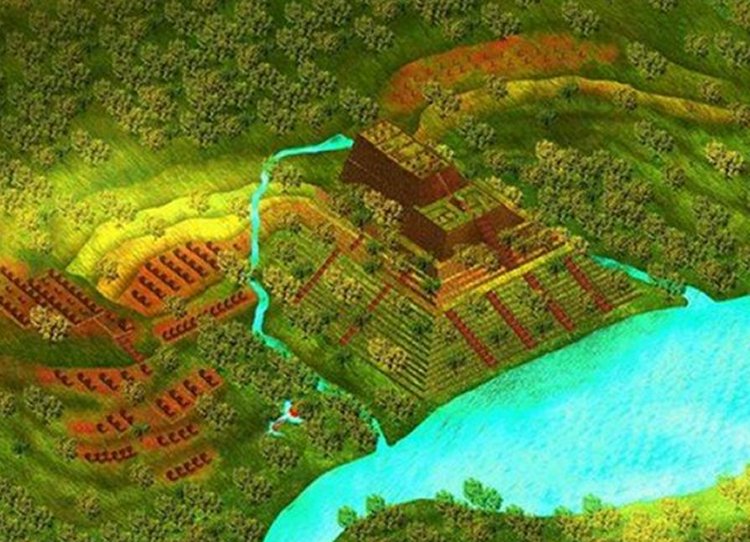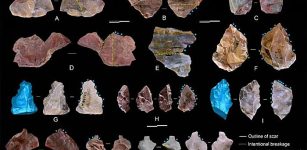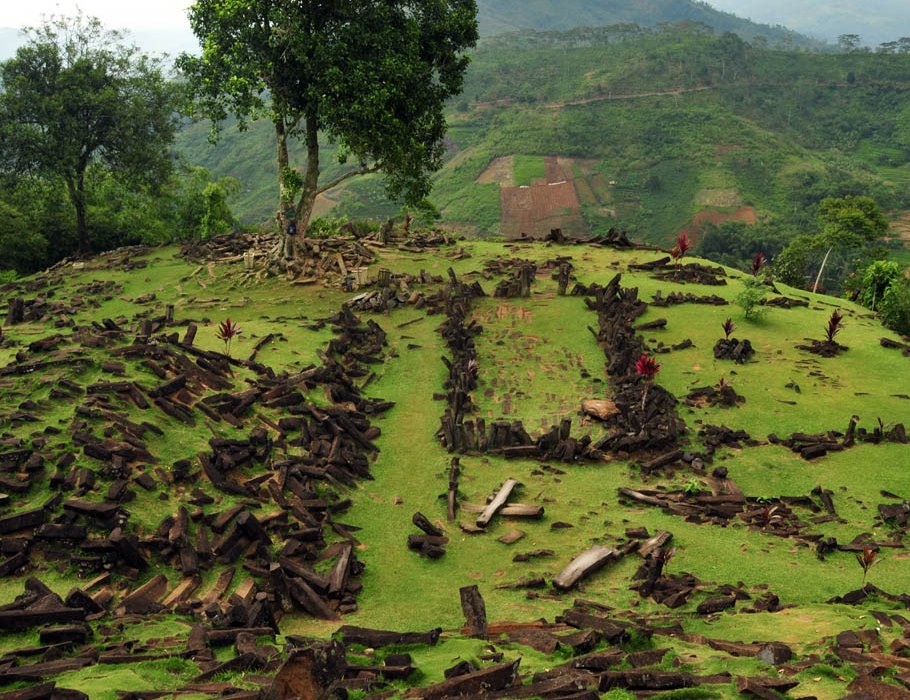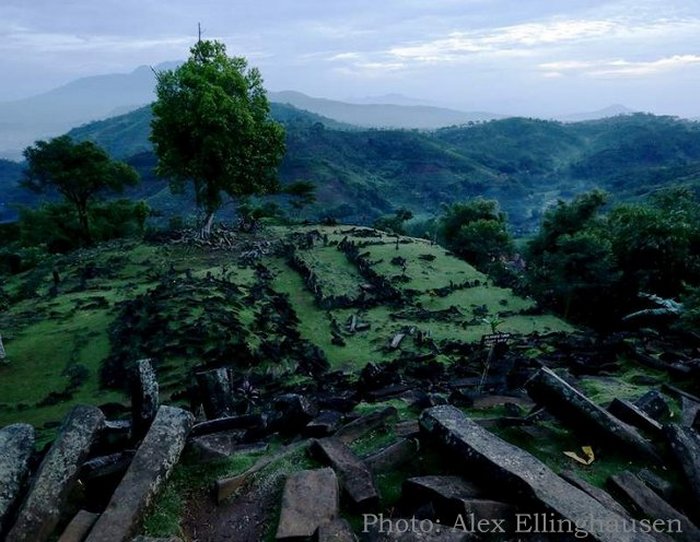Gunung Padang – Remarkable Megalithic Site In Indonesia
A. Sutherland - AncientPages.com - The megalithic complex on top of Gunung Padang has been known since the 1800s, but it was until 2011 that archaeologists published their studies regarding this one of the most fascinating sites in Indonesia.
Mount Padang Cianjur Megalithic Site.Image credit: Ilham.nurwansah - source
This remarkable megalithic site known as Gunung Padang is located 885 meters above sea level and 120 kilometers south of Jakarta, in Cianjur regency, West Java Province of Indonesia.
It occupies a hill covered with a series of terraces bordered by retaining stone walls of stone that are accessed by about 400 successive andesite steps rising approximately 95 meters.
The Sundanese people believed that Gunung Padang resulted from King Siliwangi's attempt to build a palace in one night. The asymmetric Punden Berundak faces northwest to Mount Gede and was constructed for the purpose of worship. The site was completed by 5000 BC, but some experts suggest it is much older.
According to ancient beliefs stretching back to antiquity, Gunung Padang is a sacred place. Gunung Padang (literally: Mount Padang, or Mount "Meadow/Field,"), means in the local Sundanese language "Mountain of Light" or "Mountain of Enlightenment."
Since Dutch colonists discovered it in 1914, Gunung Padang has been known as the largest among ancient megalithic sites in Indonesia.
Similar columns were used to build the Nan Madol on the island of Pohnpei in Micronesia.
 Artist’s impression of Gunung Padang as it would have looked in antiquity. Credits:© Pon S Purajatnika
Artist’s impression of Gunung Padang as it would have looked in antiquity. Credits:© Pon S Purajatnika
Where was the source of rock columns used to build the complex? The columns - perfectly suited for building different structures, even the gigantic ones - represent a unique geological formation, occurring in only a few places in the world.
Analysis of several core samples of the hill and structure have revealed greater and greater age the deeper the researchers looked. From 5000 years to 8000 years, to 10,000 years and all the way up to a reported 23,000 years old and even earlier!
These unbelievable results of the survey make Gunung Padang the oldest known structure of any kind on Earth, in fact. It is believed that the Gunung Padang structure is not a natural hill but a man-made pyramid and the origin of its construction goes back long before the end of the last Ice Age.
The sophisticated construction of Gunung Padang is massive even at the deepest levels, and its builders had extraordinary construction skills and certainly were not primitive men.
Excavations conducted in 2014 were temporarily halted when archaeologists discovered a large number of man-made artifacts and a massive structure below the surface.
The survey of the site indicates it was built in four different eras by those who were skilled engineers and possessed knowledge of astronomy and the surrounding area.
If the dating of Gunung Padang is correct, then this megalithic site was constructed when sea levels were as much as 130 meters (430 feet) lower than the present, and the current Java Sea was not a sea but fertile land.
In the landscape of this mysterious megalithic site is also included a 300-foot high pyramid whose base materials date back to 22,000 to 20,000 BC.
A sophisticated culture flourished in the region, and it was many millennia ago. Who were these people? What happened to them? Did they manage to escape before the land sank beneath the devastating waves?
Written by – A. Sutherland - AncientPages.com Senior Staff Writer
Updated on September 12, 2021
Copyright © AncientPages.com All rights reserved. This material may not be published, broadcast, rewritten or redistributed in whole or part without the express written permission of AncientPages.com
More From Ancient Pages
-
 Vindelev Treasure – Surprising Evidence Of Nordic Connection With The European Iron Age Elite
Archaeology | Apr 9, 2024
Vindelev Treasure – Surprising Evidence Of Nordic Connection With The European Iron Age Elite
Archaeology | Apr 9, 2024 -
 9,000-Year-Old Settlement Unearthed Near Jerusalem Sheds New Light On Stone Age Civilization
Archaeology | Jul 17, 2019
9,000-Year-Old Settlement Unearthed Near Jerusalem Sheds New Light On Stone Age Civilization
Archaeology | Jul 17, 2019 -
 New Tool-Making Timeline For East Asian Hominins – Study
Archaeology | Mar 9, 2024
New Tool-Making Timeline For East Asian Hominins – Study
Archaeology | Mar 9, 2024 -
 The Bimaran Casket – Rare Golden Artifact Found In Ancient Stupa
Artifacts | Dec 17, 2018
The Bimaran Casket – Rare Golden Artifact Found In Ancient Stupa
Artifacts | Dec 17, 2018 -
 Virtual Nubia: Sudan’s Medieval Monasteries Digitally Reconstructed By Polish Archaeologists
News | Oct 8, 2020
Virtual Nubia: Sudan’s Medieval Monasteries Digitally Reconstructed By Polish Archaeologists
News | Oct 8, 2020 -
 Ancestral Home Of All Humans Revealed Through World’s Largest Genome Reconstruction Of Our Ancestors
Archaeology | Jan 3, 2023
Ancestral Home Of All Humans Revealed Through World’s Largest Genome Reconstruction Of Our Ancestors
Archaeology | Jan 3, 2023 -
 Evidence Of Millennia-Old Textile Manufacture And Rare Ancient Eagle-Bone Pin Discovered In Oxfordshire
Archaeology | Jun 13, 2023
Evidence Of Millennia-Old Textile Manufacture And Rare Ancient Eagle-Bone Pin Discovered In Oxfordshire
Archaeology | Jun 13, 2023 -
 On This Day In History: Agatha Christie Known As ‘Queen Of Crime’ Died – On Jan 12, 1976
News | Jan 12, 2017
On This Day In History: Agatha Christie Known As ‘Queen Of Crime’ Died – On Jan 12, 1976
News | Jan 12, 2017 -
 More Than 2,000 Seal Impressions Found In The Ancient City Of Doliche
Archaeology | Nov 24, 2023
More Than 2,000 Seal Impressions Found In The Ancient City Of Doliche
Archaeology | Nov 24, 2023 -
 2,000-Year-Old Instruments Used By Roman Surgeons Revealed By Archaeological Scanners
Archaeology | Jul 17, 2024
2,000-Year-Old Instruments Used By Roman Surgeons Revealed By Archaeological Scanners
Archaeology | Jul 17, 2024 -
 Huge, Ancient Underground City Filled With Artifacts Discovered In Mardin, Turkey
Archaeology | Apr 20, 2022
Huge, Ancient Underground City Filled With Artifacts Discovered In Mardin, Turkey
Archaeology | Apr 20, 2022 -
 Namoratunga: ‘People Of Stone’ And Ancient Astronomical Observatory
Featured Stories | Jun 12, 2016
Namoratunga: ‘People Of Stone’ And Ancient Astronomical Observatory
Featured Stories | Jun 12, 2016 -
 Galileo Galilei’ Long-Lost Letter Reveals His Attempt To Fool The Inquisition And Make Science Independent From Religion
Archaeology | Sep 22, 2018
Galileo Galilei’ Long-Lost Letter Reveals His Attempt To Fool The Inquisition And Make Science Independent From Religion
Archaeology | Sep 22, 2018 -
 Solutrean People: Were First Americans European Stone Age People?
Civilizations | Feb 23, 2018
Solutrean People: Were First Americans European Stone Age People?
Civilizations | Feb 23, 2018 -
 Sed Festival – Ancient Egyptian Ritual Tested Pharaohs
Ancient History Facts | Mar 28, 2018
Sed Festival – Ancient Egyptian Ritual Tested Pharaohs
Ancient History Facts | Mar 28, 2018 -
 Celtic Valhalla And Sacred Wells – Magic Of Invisible Worlds
Celtic Mythology | Nov 17, 2021
Celtic Valhalla And Sacred Wells – Magic Of Invisible Worlds
Celtic Mythology | Nov 17, 2021 -
 Famed Makishi Dancers And Likumbi Lya Mize Ceremony In Zambia – Much More Than Just A Festival
Ancient Traditions And Customs | Aug 6, 2019
Famed Makishi Dancers And Likumbi Lya Mize Ceremony In Zambia – Much More Than Just A Festival
Ancient Traditions And Customs | Aug 6, 2019 -
 Animal Tracks And Human Footprints In Prehistoric Hunter-Gatherer Rock Art In Namibia
Archaeology | Sep 13, 2023
Animal Tracks And Human Footprints In Prehistoric Hunter-Gatherer Rock Art In Namibia
Archaeology | Sep 13, 2023 -
 Neanderthals Invented Or Developed Birch Tar Making Technique Independently From Homo sapiens
Archaeology | May 30, 2023
Neanderthals Invented Or Developed Birch Tar Making Technique Independently From Homo sapiens
Archaeology | May 30, 2023 -
 Never-Before-Seen Amazon Rock Art Reveal People Lived With Giant Ice Age Animals
Archaeology | Dec 5, 2020
Never-Before-Seen Amazon Rock Art Reveal People Lived With Giant Ice Age Animals
Archaeology | Dec 5, 2020


